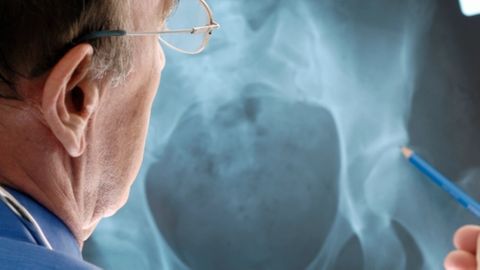Romosozumab Increases Bone Mineral Density, Effect Amplified is Followed with Antiresorptive Medication
A new ACR study details the effects of romosozumab on bone mineral density gains when followed or preceded with antiresorptive medications such as alendronate or denosumab.

New data from the American College of Rheumatology annual meeting details the substantial improvements in bone mineral density (BMD) seen in the hip and lumbar spine within one year of beginning treatment and suggests there could be potential for greater bone density if patients were transitioned to another antiresorptive drug after this period.
Results of the study suggest patients receiving romosozumab for 2 years followed by alendronate or denosumab improved total hip BMD by more than 7% while those who received romosozumab after therapy with denosumab only achieved gains of 3.8%.
“Romosozumab exerts a unique mechanism of action on bone tissue. It increases bone formation and decreases bone resorption. When it’s given as initial therapy for one year, followed by an antiresorptive medication such as alendronate or denosumab, the treatment sequence significantly increases BMD and reduces fracture risk compared to both placebo and alendronate treatment,” said lead investigator Felicia Cosman, MD, professor of Medicine at Columbia University College of Physician and Surgeons in New York City, in a statement. “This study was designed to determine if, despite the different mechanism of action for romosozumab versus teriparatide, the effect on BMD would be different when romosozumab was given as the second treatment, after an antiresorptive medication, compared to using romosozumab first.”
With an interest in illustrating bone resorption based on treatment sequences with romosozumab, investigators designed the current study as an analysis of 4 clinical trials where patients received romosozumab before or after an antiresorptive medication. Of the trials chosen for inclusion, Phase 3 ARCH and phase 3 FRAME included patients who received romosozumab prior to an antiresorptive while the phase 3 STRUCTURE and a phase 2 study examined use of romosozumab after an antiresorptive.
In the ARCH trial, patients experienced total hip BMD increases of 6.2% at 1 year with romosozumab and 7.1% after 2 years of treatment with the romosozumab and alendronate sequence. For lumbar spine BMD in ARCH, investigators found patients experienced a 13.7% increase in BMD with 1 year of romosozumab and a total of 15.2% increase with the 2-year romosozumab and alendronate sequence. In the FRAME trial, patients experienced total hip BMD increases of 6.8% at 1 year with romosozumab and 8.8% after 2 years with the romosozumab and denosumab sequence. For lumbar spine BMD in FRAME, investigators found patients experienced a 13.3% gain in BMD with 1 year of romosozumab and a total of 17.6% increase with 2-year romosozumab and denosumab sequence.
In the STRUCTURE trial, patients who were previously treated for a year or longer with alendronate prior to treatment with romosozumab experienced a total hip BMD gain of just 2.9% after 1 year wit romosozumab. For lumbar spine BMD, investigators found the total BMD gain after 1 year with romosozumab was 9.8%. In the phase 2 study, patient who were previously treated for a year or longer with denosumab prior to treatment with romosozumab experienced a total hip BMD gain of 0.9% after 1 year of romosozumab treatment and 3.8% after the 2-year denosumab and romosozumab sequence.
For lumbar spine BMD, investigators found patients in STRUCTURE experienced a total BMD gain of 9.8% with 1 year of romosozumab and patients in the phase 2 study experienced a BMD gain of 5.3% after 1 year of romosozumab and 11.5% after 2 years of the denosumab and romosozumab sequence.
“The standard approach that most health care providers use is to start treatment with antiresorptive medicine. However, bone building agents like romosozumab, abaloparatide and teriparatide reduce fracture risk faster than antiresorptive medicines. There are about two million fractures every year from osteoporosis,” Cosman added. “Patients need to know that the best option for them might be to receive a bone building medication first, rather than an antiresorptive treatment.”
This study, “Treatment Sequences with Romosozumab Before or After Antiresorptive Medication,” was presented at ACR Convergence.